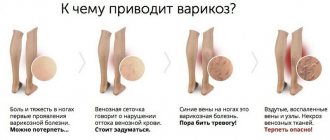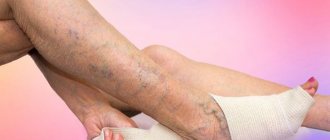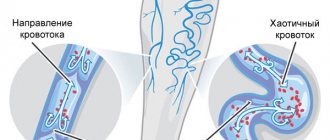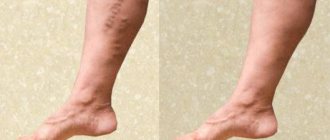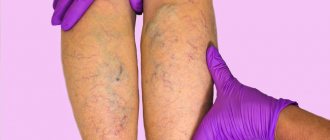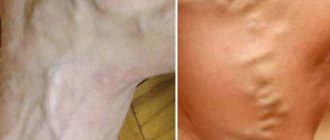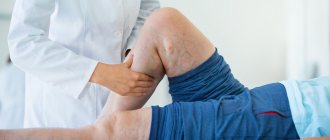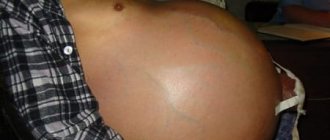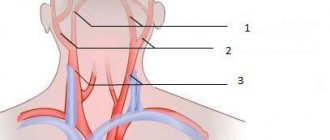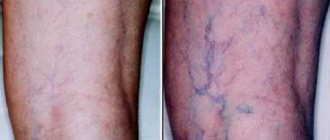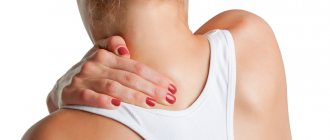Protruding veins on the legs: reasons, photos
We figured out why the veins protrude on the legs. But what is the cause of varicose veins? The disease can be primary or secondary. In the first case, it manifests itself in a person with a predisposition to varicose veins, in the second - as a result of an injury in which the vascular walls were damaged and blood clots formed.
The following causes of pathology are distinguished:
- Heredity. If a person’s relatives suffered from varicose veins, he is also at risk. In this case, you need to be prepared for the onset of the disease and pay attention to prevention before the first symptoms appear.
- Sedentary work. Varicose veins threaten drivers, pilots, office workers, as well as those who stand at work for a long time (hairdressers, salesmen, etc.).
- Heavy physical activity and professional sports.
Heavy physical activity is one of the causes of vein pathology
- Completeness. Most often, varicose veins are observed in overweight people, since their weight puts pressure on the vessels in the legs and complicates blood circulation in the extremities. In addition, obese people tend to exercise less.
- Drinking alcohol, smoking, unhealthy diet. Such habits disrupt metabolism and cause vein diseases.
- The disease is also common in pregnant women. Most of them complain about this problem in the second trimester of pregnancy. The fact is that as the child grows, the pressure on the limbs and veins also increases.
- Uncomfortable shoes and clothes. The disease can provoke an addiction to high-heeled shoes and tight underwear.
Why do they appear?
The formation of pigmentation begins with the fact that the valves of the vessels that allow blood to pass upward work intermittently. The blood flow becomes chaotic, and in places where the valves do not work, stagnation occurs and pigment spots form on the skin. Malnutrition of soft tissues causes redness.
The red spots darken, thicken and itch. At the next stage, the spots are already brown, liquid oozes through them, most often they are localized in the ankle area. If the moment is missed, adequate treatment is not applied, at the fourth stage trophic ulcers are formed, often complicated by infections.
With advanced varicose veins, complications arise:
- Microbial eczema . Due to varicose veins, the barrier function of the skin is reduced and it is more difficult for the body to fight back pathogens. Under the influence of such a continuous “bombardment”, microbial eczema starts. The source of inflammation is clearly defined red spots, the skin flakes and itches. Redness of the lower leg occurs more often.
- Lipodermatosclerosis , which is caused by impaired blood circulation in the dermis. With chronic venous insufficiency, the pressure in the lumens of blood vessels increases. As a result, the blood plasma leaves the channel and moves into the subcutaneous tissue. The protein contained in it, under the influence of tissue enzymes, changes and is perceived by the body as a foreign substance. This is how the inflammatory process and accompanying signs begin: red spot, itching, peeling, erosion, purulent formations.
- White skin atrophy . Pathological changes in the veins lead to atrophy of adjacent skin areas. There is no inflammatory process as such, but irregularly shaped scars form on the skin, outlined by rims of hyperpigmented skin.
Untimely or incorrect treatment leads to thrombosis of blood vessels and oxygen deficiency in tissues, resulting in the formation of blue spots on the skin. Bruises appear that do not go away for a long time. Blue spots indicate that the disease has become chronic. In some areas they are almost purple.
Blue spots and their gradual blackening are an alarming symptom of the transition of varicose veins to the final stage. If the leg is already turning black, the question of surgical intervention may be raised.
What to do if veins protrude on your legs
If you notice that the veins on the back or sides of your legs are protruding strongly, consult a doctor immediately. Some people don't know which doctor to see, so they put off treatment. A phlebologist deals with venous diseases, but first, in any case, you can consult a therapist.
Expert opinion
Despite the fact that varicose veins have characteristic signs, which are usually sufficient to diagnose the presence of pathology, it is recommended to undergo additional diagnostics to make an accurate diagnosis and determine the extent of the lesions. Most often it includes ultrasound of the veins of the lower extremities.
Vascular surgeon, phlebologist
Osipova Ekaterina Yakovlevna
Such symptoms indicate a serious stage of the disease, at which preventive measures are no longer sufficient. Treatment at this stage includes taking medications and vitamins, using external agents (creams, ointments), as well as medical procedures and gymnastics.
The late stage of the disease is very dangerous, as it entails serious complications: for example, thrombophlebitis. Therefore, in this case, you need to urgently consult a doctor.
Most patients are best helped by complex therapy, a combination of venotonic drugs with creams and ointments for external use. Regular contrast showers and light sports will also improve the condition of your limbs.
Who is more susceptible to CVI?
Since women are more likely to suffer from varicose veins, they also experience symptoms of CVI more often. Many women over 30 years old gradually begin to experience the manifestations of this disease.
Often, pregnancy and childbirth contribute to the development of this pathology. This is due to the fact that during this period, women often develop varicose veins, or worsen existing ones.
The development of venous insufficiency is facilitated by the modern lifestyle of most citizens. From a young age, many people spend most of their time sitting in a chair or chair.
Sedentary work without movement aggravates varicose veins and causes its complications. It is also harmful to be constantly standing.
Veins on the legs protrude: treatment
Treatment of this pathology can be conservative or include surgery. Sometimes two types of treatment are combined to achieve maximum effect, reduce inflammation and pain, speed up blood circulation and valve function.
Treatment of vein pathology with drugs
Treatment with medications involves the use of anticoagulants (if complications develop - thrombosis) and venotonics. Also, while taking medications, it is imperative to adjust your diet and start doing therapeutic exercises. As an additional preventative measure, all kinds of compresses for the legs, cool showers, compression garments and cream are prescribed.
Expert opinion
Also, along with drug therapy, surgical treatment of veins is used. In the first stages, laser treatment is effective, in which the laser is applied to the inner wall of the varicose vein. The wall is heated under the influence of the beam, and the patient does not feel severe pain. Thanks to laser treatment, bulging veins in the legs of men and women disappear within a few months.
Vascular surgeon, phlebologist
Osipova Ekaterina Yakovlevna
In addition, radiofrequency ablation (Ablatio) is used in surgical treatment. With this method, body tissues are exposed to radio frequency frequencies. The varicose vein is punctured and a waveguide pre-connected to a radio frequency generator is inserted into it. On the computer, doctors see the temperature in the vessel. Using the device, the venous walls are heated to reduce the lumen. In this case, the device affects only the walls of blood vessels, but it can only be used on large vessels.
Another common method of treating varicose veins is sclerotherapy. It is classified as a chemical method. A special medicine is injected into the enlarged lumen of the vein, which promotes its narrowing and gluing. The method is suitable for small veins, but for large veins it is not effective enough.
Why do black spots appear with CVI?
Our heart pushes blood to all the organs of our body through the arteries. This arterial blood contains oxygen, without which our organs cannot function. This blood is bright red.
Second block of advertising
From the organs, blood enters the veins without oxygen. Venous blood is dark red in color. This blood and veins must return back to the heart and lungs in order to saturate it with oxygen again.
However, it is much more difficult to lift blood to the heart, because the blood is now affected by gravity. To prevent blood from returning back, there are special valves in the veins that prevent the blood from flowing back.
When we walk, the muscles in our legs act as a pump, helping to push blood through the veins to the heart.
If you have a congenital predisposition, or you lead a sedentary lifestyle, the muscles of your legs do not take part in the movement of blood. At the same time, the load on the valves in the veins increases.
Protruding veins on the legs: treatment with folk remedies
The use of folk remedies is advisable in the initial stages of the disease. Also, such procedures are used as prevention in people at risk. Many people ignore pills because of their high cost and prefer traditional medicine. Such treatment can be effective, but you should first consult a doctor and consult about the advisability of using certain methods.
Treatment of varicose veins with herbal decoctions
In folk medicine, varicose veins are treated with herbal decoctions, infusions, compresses and ointments. Decoctions and infusions are prepared for both internal and external use. Most recipes use pharmaceutical chamomile, horsetail, St. John's wort and chestnut. Active components in natural herbs, fruits and roots help restore vascular elasticity, reduce swelling and inflammation.
Some foot creams are also made based on natural ingredients. For example, the composition of the NORMAVEN® foot cream is represented by 12 natural ingredients, including plant extracts, oils and vitamins that have a venotonic effect. This product has undergone clinical trials and has proven itself well among patients and phlebologists. And the composition of the venotonic tonic "NORMAVEN®" is represented by extracts of horse chestnut, which strengthens the walls of blood vessels, extracts of witch hazel and butcher's broom, menthol and panthenol. All these active components in combination provide a powerful effect in strengthening blood vessels, relieving swelling, reducing pain and inflammation. Therefore, such products should be used by all people with sedentary work or a hereditary predisposition. Specialists from a pharmaceutical company worked on the development of NORMAVEN® tonic and cream; these products have been tested and have a package of necessary documents and certificates.
Medicinal baths
!
One of the most popular folk remedies for the treatment of varicose veins is medicinal baths.
They also help with thrombosis (Thrombosis) and thrombophlebitis (Thrombophlebitis). To prepare such a bath, you need to mix 500 g of oak, willow, and chestnut branches. Pour boiling water over the branches and cook for 30 minutes. After this, medicinal herbs are added to the solution. You will need four packs of St. John's wort, string and chamomile. The finished broth should be left overnight. In the morning, the product is added to the bath.
They also make foot baths with soda. You need to add seven tablespoons of soda to a hot bowl and steam your feet in it. In addition, you can take baths as much as possible with willow bark. To do this, you need to boil willow branches in boiling water for half an hour, and then add the decoction to the bath.
